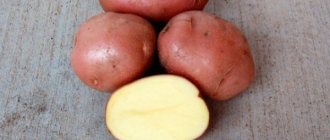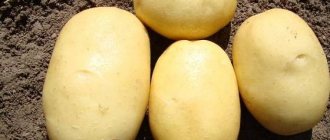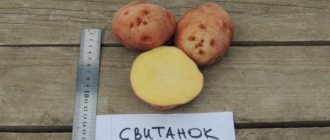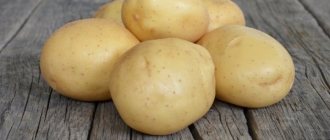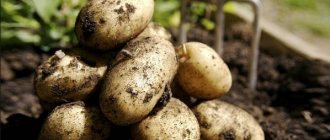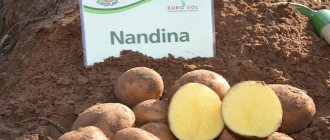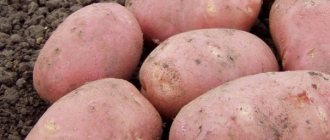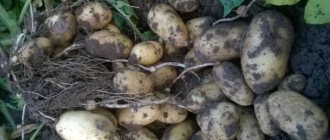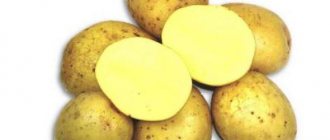Description and characteristics
The main characteristics of “Latona” that potato growers pay attention to are the ripening period and yield of the variety. However, other parameters are also important for proper cultivation of the crop.
| Characteristic | Description |
| Purpose of the Latona variety | Dining room. 96% of the harvest remains marketable. |
| Ripening period | Early. Harvest 75 days after planting. The first digging can be done after 45 days. |
| Appearance of the bush | Tall, erect, curvy. The foliage of the stems is good, so the variety does not suffer from drying out soil. |
| Flowers | The corollas are white, the number of flowers on the bush is average. There may be a lack of flowers, which does not affect the yield. |
| Leaves | The leaves are dark green, large. The tops are lush and dense, this characteristic makes it possible to water the bushes moderately. |
| Tubers | Round-oval shape, smooth. The peel is yellow, the flesh is light yellow. The peel is delicate and can be easily separated if harvested in a timely manner. Tubers overexposed in the ground have a rough skin. The weight of one fruit ranges from 90 to 140 grams. Quantity in a bush – 15 pieces. |
| Productivity | From one bush 2.5 kg. When grown in fields it is 45 c/ha. |
| Resistance to diseases and crop pests | Latona potatoes are not affected by tuber blight, cancer, dry rot and do not suffer from damage from the golden potato nematode. |
Growing
The agricultural technology for growing this variety is not complicated; it is standard and includes basic techniques: loosening, mulching, watering, fertilizing.
When and how to apply fertilizers and how to do it correctly when planting, read in separate materials on the site. We also bring to your attention articles about alternative methods of growing potatoes: Dutch technologies, under straw, in barrels, in bags.
Advantages and disadvantages
The pros and cons of Latona potatoes are well covered in reviews from vegetable growers. Based on the experience of potato growers, a visual table can be drawn up.
| Advantages | Flaws |
| Potato resistance to mechanical damage, ability for mechanical planting, maintenance and harvesting. | The variety is affected by scab. |
| Short growing season. | If harvested untimely, the skin on the tubers becomes very rough. |
| Ability for long-term transportation. | |
| Good tuber growth throughout the season due to the gradual death of the tops. | |
| Resistance of the Latona variety to weather changes | |
| High shelf life, the yield during storage is preserved by 97%. |
Potatoes Latona: reviews from gardeners about the variety
Potatoes Latona: photo of variety
- Svetlana Vladimirovna, Sverdlovsk region: “At one time I made a choice in favor of growing Latona potatoes and never wished for it. The variety is not at all picky about weather conditions and consistently produces good yields.”
- Margarita Ivanovna, Moscow region: “What I like most about the Latona potato variety is that it can be stored for a very long time and does not rot over time. And he’s not afraid of long-distance transportation, so we often deliver fresh harvests to relatives in other cities.”
- Kristina Vasilyevna, Chelyabinsk region: “I have been growing Latona potatoes for a long time. I like the pleasant taste and the fact that the variety is able to grow and produce an excellent harvest even in a cold (or, conversely, too hot) summer.”
Landing
To get a high yield, Latona potatoes are planted taking into account the requirements of crop rotation. The variety grows well after cabbage, legumes, root vegetables and pumpkins. But tomatoes or peppers are undesirable predecessors.
There are three main ways to plant potatoes:
- trench;
- ridge;
- smooth.
All three are equally suitable for the Latona variety. Gardeners choose which way to plant Latona depending on the climate and soil composition.
- The trench method involves digging trenches into which prepared potato tubers are then laid out. The depth of each trench is 15 cm, and the distance between adjacent trenches is 70 cm. Seed potatoes are placed at a distance of 35-40 cm from each other, then sprinkled with soil. The method is ideal for sandy, light soil that does not retain moisture and for regions with warm climates.
- The smooth planting method is best known to amateur potato growers. In this case, a layer of earth is raised, potatoes are laid with their sprouts facing up and sprinkled with soil. This solution is suitable for areas where there is no stagnant water and good lighting. A distance of 70 cm is maintained between the Latona tubers and they are planted in a checkerboard pattern in two rows. Planting depth – 10 cm.
- The ridge planting option is chosen for heavy soil with excess moisture. The earth is raised to a height of 15 cm in the form of a mound. The optimal distance between ridges is 70 cm, between potato bushes 30 cm.
Pre-planting preparation of tubers is required - germination, treatment against pests and diseases. For processing, gardeners use preparations such as Albit or Maxim. The product is used according to the instructions.
Important! Potatoes of the Latona variety do not tolerate stagnant water.
If such a danger exists, it is necessary to provide for the possibility of drainage of the site.
At the time of digging, manure, humus, and mineral fertilizers are added.
For Latona potatoes, the best planting time is early May. The ridges are located from north to south.
Productivity
When the crop is grown in a full cycle, 40-45 tons of potatoes are obtained from each hectare of plantings, which is considered an excellent result. The overall yield depends on the growing conditions. On average it ranges from 82 to 95%. Regardless of whether the season is dry or rainy, the Latona potato crop is equally well formed. Description of the variety, photos, and reviews from experienced gardeners suggest that in garden plots, with proper care, you can harvest up to two kilograms of tubers or more per bush.
Care
After planting, standard care measures are provided for potato beds. The Latona variety responds very gratefully to the careful fulfillment of agrotechnical requirements. If you pay enough attention to it, the yield rises to its maximum level. The most basic stages of caring for Latona potatoes are watering, loosening, hilling, fertilizing, and prevention from pests and diseases.
Watering is most useful at the time of bud formation and flowering of the bushes. The rest of the time, potatoes do not require regular moisture. For the variety, drip irrigation and sprinkling are used.
Weeding the beds. A necessary event for potatoes. The beds are weeded for the first time a week after planting.
Fertilizing is combined with watering.
Preventative measures to prevent the occurrence of diseases and pests should be done regularly. Potatoes of the “Latona” variety should be protected from the invasion of the Colorado potato beetle, which can cause great damage to plantings.
Hilling and feeding
Gardeners do not have the same opinion regarding the hilling of the Latona variety. But the climatic conditions and soil composition on the site should be taken into account. When potatoes are hilled inside the nest, the temperature increases. When it reaches +20°C, tuberization slows down. Therefore, some consider this procedure unnecessary. But hilling is necessary to protect the potatoes from possible cold snap, accumulation of moisture and stimulating the growth of tops. This significantly increases productivity. The first time Latona potatoes need to be hilled when sprouts appear. Then after watering or rain. It is important to carry out hilling before flowering.
It is best to feed the potato variety with mixed fertilizers. For potatoes, you need to alternate mineral and organic nutrition.
How to feed Latona potatoes:
- When planting, add 1 tbsp. a spoonful of nitrophoska in each well.
- At the moment of green mass collection, add semi-liquid mullein or a composition of 1 tbsp. spoons of urea in a bucket of water. 0.5 liters of any fertilizer is enough.
- During the budding period, it is necessary to feed the potato bushes with potassium. Wood ash (3 tbsp) and potassium sulfate (1 tbsp) in a bucket of water are suitable.
- In the flowering phase, granular superphosphate is used.
Diseases and pests
The variety is classified as disease-resistant, but it is not recommended to neglect preventive treatments. You need to start with preventive treatment of tubers before sowing.
| Name of pest or disease | Control and prevention measures |
| Late blight, alternaria | Spraying with Metaxil. The frequency of treatments is once every 14 days. Spraying with garlic infusion |
| Wireworm | Repellent by the smell of planted mustard, legumes or calendula. |
| Colorado beetle | Dusting with ash, mulching with onion peels |
How to store the variety in the cellar?
Gardeners often use this very room for wintering Latona. There the tubers are placed in boxes with small holes, or in bins. The layer should not be more than 1.5 m, so that excess water leaves the root crops and air penetrates them. It is advisable to place the boxes on pallets made of boards at a short distance from the wall to avoid rotting of the potatoes.
Tubers are better preserved if elderberry, rowan, wormwood, and wormwood leaves are added to them. At least once a month you need to check the condition of the vegetable. With timely removal of spoiled tubers, ventilation, maintaining a constant temperature, and placing buckets of lime next to the potatoes, the crop will be perfectly preserved until the new season.
Harvesting
Early varieties, which include “Latona,” begin to be harvested in early July. Although the period may shift depending on the growing region. The harvested crop is laid out on a ridge.
At the same time, the most productive bushes are determined and the tubers are left for seed. A few hours after drying, the potatoes are prepared for storage. Only healthy, undamaged tubers are selected. The rest are placed separately for quick consumption.
Before planting, “Latona” potatoes are treated (sprayed) with copper sulfate (2 g per bucket of water). This technique increases shelf life.
Important! The tubers selected for storage are well dried.
The maximum temperature for storing Latona potatoes is +5°C, humidity 90% and no light.
How to process harvested vegetables?
After harvesting, the potatoes are left in the sun for several hours to dry. Ultraviolet light kills bacteria and fungi. Before storing a vegetable, it is sorted: all infected, “baked,” deformed or rotten root vegetables are discarded. Potatoes with cuts, scratches, or dents are placed separately to be used immediately. They should not be placed in the same container with healthy tubers.
To extend the storage of root vegetables, they need to be pickled with a solution of copper sulfate. To do this, 2 g of the substance is dissolved in 10 liters. water and spray the tubers. The planting material is also landscaped. Potatoes used for food and seeds are stored in different places. If the location of the bookmark is the same, then in different corners.
Until now, many summer residents argue about whether it is worth washing root vegetables. There is still no consensus on this issue. Some are sure that this cannot be done, otherwise the tubers will rot. Others say that this is the only way the potatoes will be preserved well until spring. Both are right in their own way. In fact, it doesn’t matter at all whether washed potatoes are stored for the winter or not. The main thing is that the root vegetables intended for storage are well dried. Then he will last a long time. The shelf life also depends on the room temperature. It should not exceed + 5 degrees. The vegetable requires darkness and humidity of approximately 91%.
Advantages of washed potatoes:
- when preparing root vegetables for storage, you can see what condition they are in, because the slightest damage is noticeable on clean skin;
- good presentation, which is important for sale;
- It will be much easier to clean the cellar after winter
Flaws:
- Root crops that are not completely dried will quickly deteriorate during wintering;
- It will take longer to prepare the tubers for storage and require a lot of effort;
- a large harvest will require a lot of water;
- drying requires a separate area
According to experts, it is necessary to wash potatoes only if the crop was harvested in dirty weather, when it is simply impossible to peel the tubers by hand.


